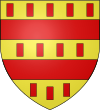Merxheim
Merxheim is a small town and Ortsgemeinde in the Bad Kreuznach district in Rhineland-Palatinate, western Germany.
His two children, Rorich and Adelheid, shared between themselves their father's allodial holdings (lands held in fief) in Merxheim.
From 1798 to 1814, Merxheim was French and found itself grouped into the Canton of Meisenheim, the Arrondissement of Birkenfeld and the Department of Sarre.
After Revolutionary and Napoleonic French rule, Merxheim passed in 1815 under the terms of the Congress of Vienna to the Kingdom of Prussia, only to pass the very next year to the Landgraviate of Hesse-Homburg, under whose sovereignty it remained until the Austro-Prussian War in 1866, when the Kingdom of Prussia, having achieved hegemony over a great many German states in this war, annexed, among other places, Merxheim and assigned it to its new Rhine Province and, within this, to the Meisenheim district.
Some children playing in a barn managed to start a fire that led to such a great blaze that within three hours, 107 houses and their associated commercial buildings went up in flames.
The old “Nürnberger Turm”, a tower that for centuries had been held to be Merxheim's defining landmark, was thoroughly gutted and was later torn down.
Towards the end of the 18th century, the number of Jews in the village had shrunk: In 1801, there was only one Jewish family still living in Merxheim, Jacob Bär's family, who lived at the so-called Freihaus (“Free House”), a former noble seat across the street from the church (today: Hauptstraße 22).
Also belonging to the Jewish community in Merxheim were the Jews living in Simmern unter Dhaun (Simmertal), although they did have their own prayer room.
This explains the relatively quick flight to the towns and cities, as was the case with the horse dealer Daniel Fried II, who together with nine family members moved in 1870 to Sobernheim, where his particular trade was seeing a great upswing as a result of both the railway connections and the then current Franco-Prussian War.
The village's Jewish parents made efforts at that time to have their children schooled together with those from neighbouring Bärweiler, but this came to naught.
One member of Merxheim's Jewish community died as a result of wounds sustained in the First World War, Karl Michel (d. November 1918), while another, Arthur Loeb, was awarded the Iron Cross, First Class.
In the years that followed, though, all of them moved away or even emigrated in the face of the boycotting of their businesses, the progressive stripping of their rights and repression, all brought about by the Nazis.
According to the Gedenkbuch – Opfer der Verfolgung der Juden unter der nationalsozialistischen Gewaltherrschaft in Deutschland 1933-1945 ("Memorial Book – Victims of the Persecution of the Jews under National Socialist Tyranny") and Yad Vashem, of all Jews who either were born in Merxheim or lived there for a long time, 17 were victims of Nazi persecution (birthdates in brackets): Like many places in the region, Merxheim can claim to have had its dealings with the notorious outlaw Schinderhannes (or Johannes Bückler, to use his true name).
Appearing as a witness as early as 1075 in a document from Archbishop Udo of Trier was a man named Albert von Merkedesheim.
Seen on the sinister (armsbearer's left, viewer's right) side in Merxheim's arms is a charge depicting, in stylized form, a building that for centuries was Merxheim's defining landmark, the old Nürnberger Turm (“Nuremberg Tower”), which burnt down in the great fire that beset the village on 24 July 1870.
[12][13] The following are listed buildings or sites in Rhineland-Palatinate’s Directory of Cultural Monuments:[14] In the earlier half of the 19th century, there might have been a prayer room in one of the Jewish houses.
It was meant as a central synagogue for Jewish families from not only Merxheim but also Meddersheim, Bärweiler, Martinstein and Simmertal.
The by then already shrinking Jewish community, despite its determined efforts, found it impossible to muster the wherewithal needed to build a new one.
The last efforts to build the synagogue anew were undertaken in 1910 with the help of a collection, but the outbreak of the First World War, the plans were shelved.
The graveyard lies southwest of Merxheim on the pathway across the heights at a woodland called “Meckenbacher Wald”.
